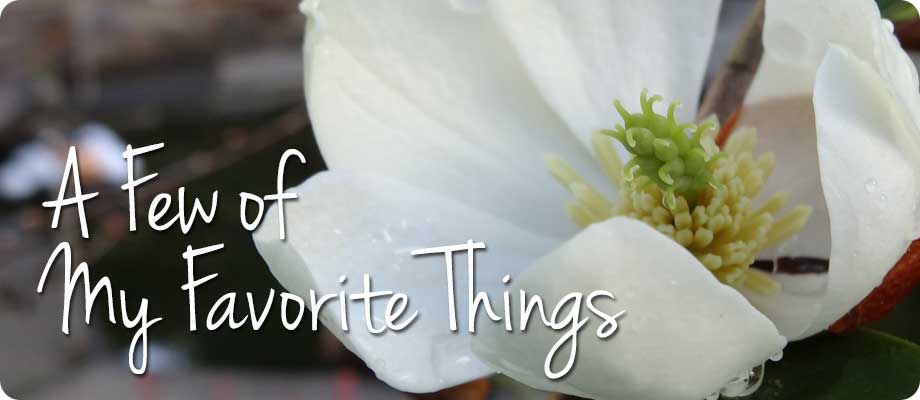
by Kristen | May 10, 2014 | gardening, plants
Of the many things I can list as one of my favorite things, rain is not one of them. As of today we have a 110% of our total rainfall for May, it is only the 5th. Lots of people just moan about it but the brave, raindrop-dodging gardener eagerly waits for a break in the rain to run out to see what is happening. We are all hoping that spring will be the rainy season and we will be rewarded with a long hot summer.
My plants are actually holding up well under the deluge. They are bravely showing their tender petals and fresh greens. Come with me as we take a quick tour of my garden and see what’s out there.
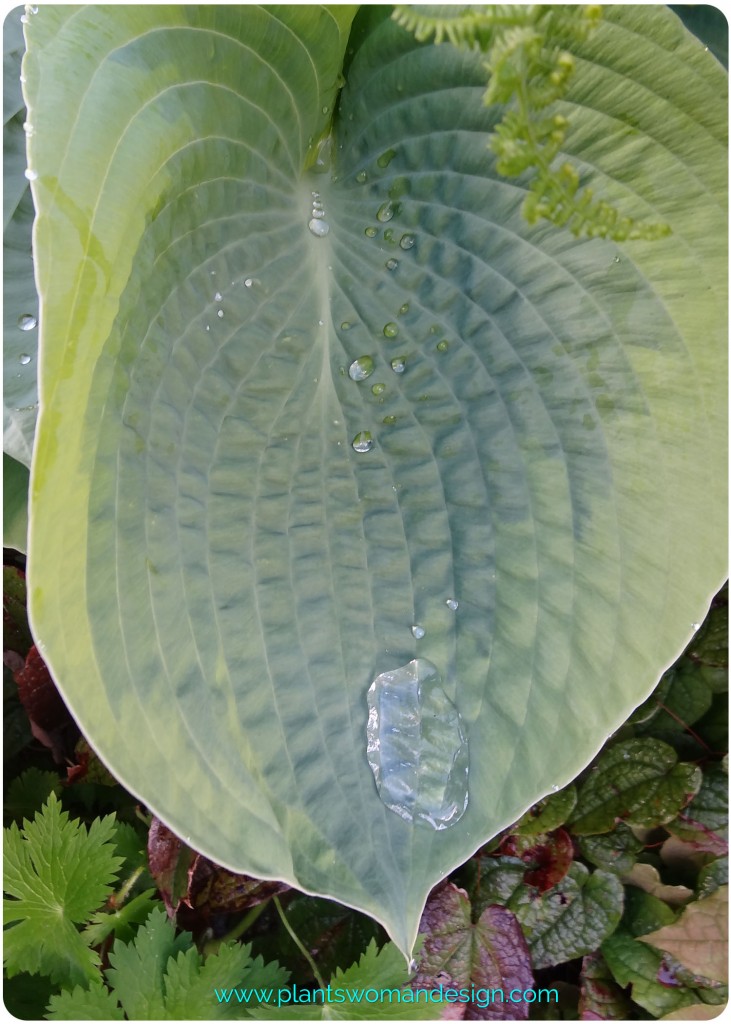
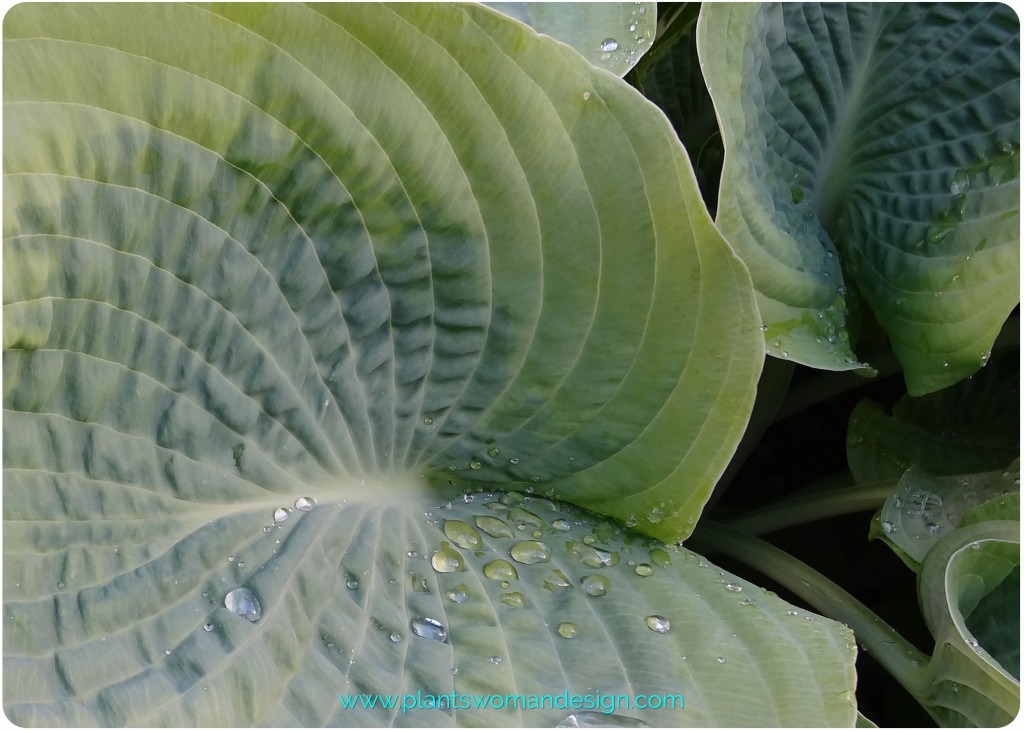
I am a big fan of color and texture. Flowers don’t always thrill me but sometimes they just demand my full attention. Then again blossom and texture can go together. This Magnolia Twanensis is fabulous this year with gigantic buds and plenty of them.
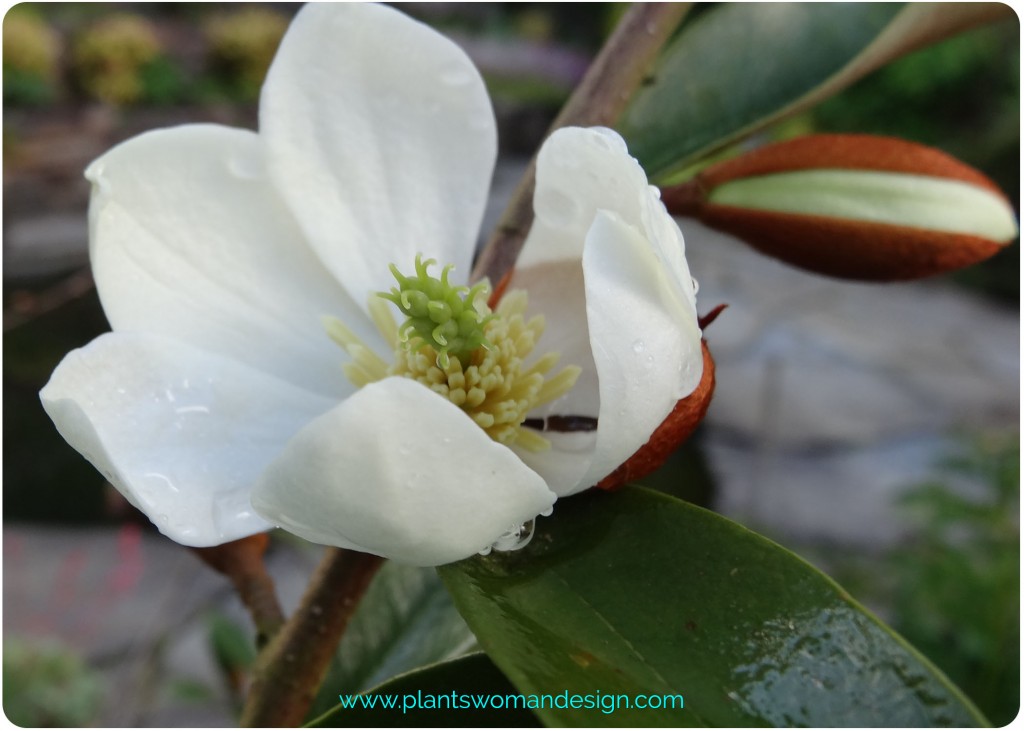
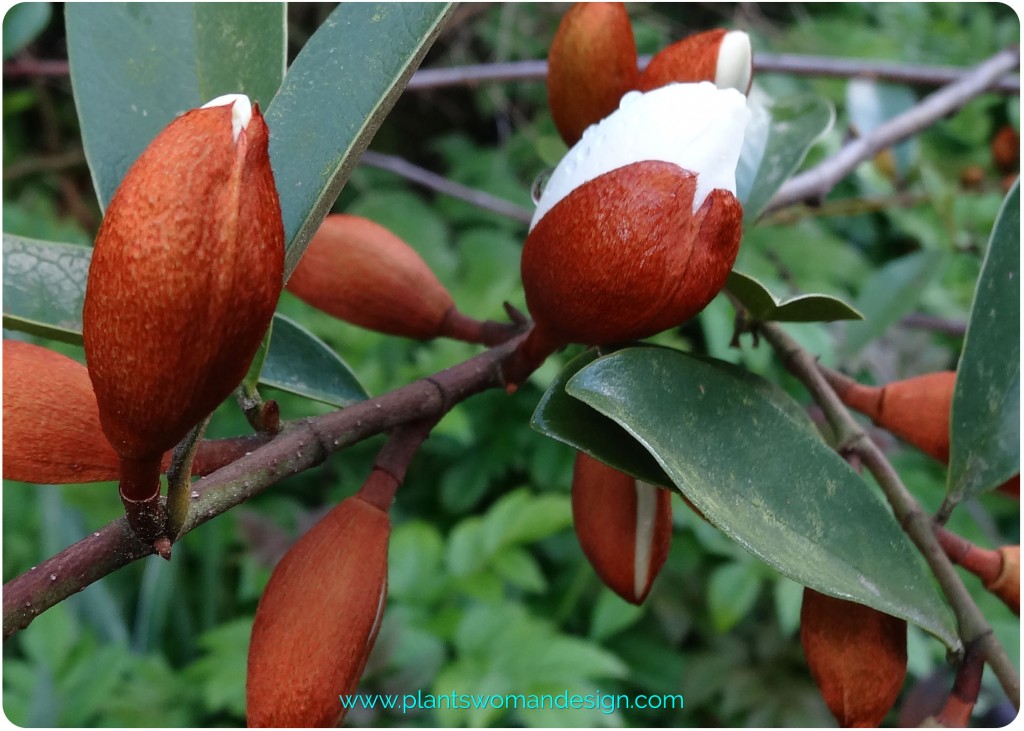
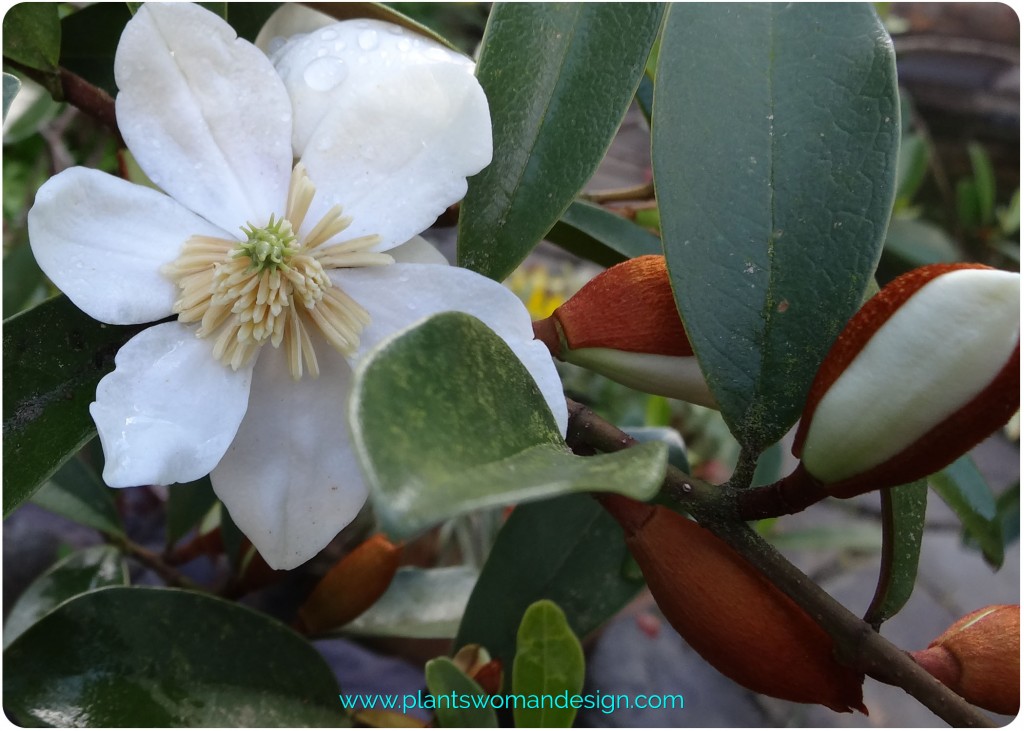
Peonies have light texture with delicate, tissue like petals. They are holding their heads up high and looking beautiful even through the rain. This is peony kinkaku is new to me this year.
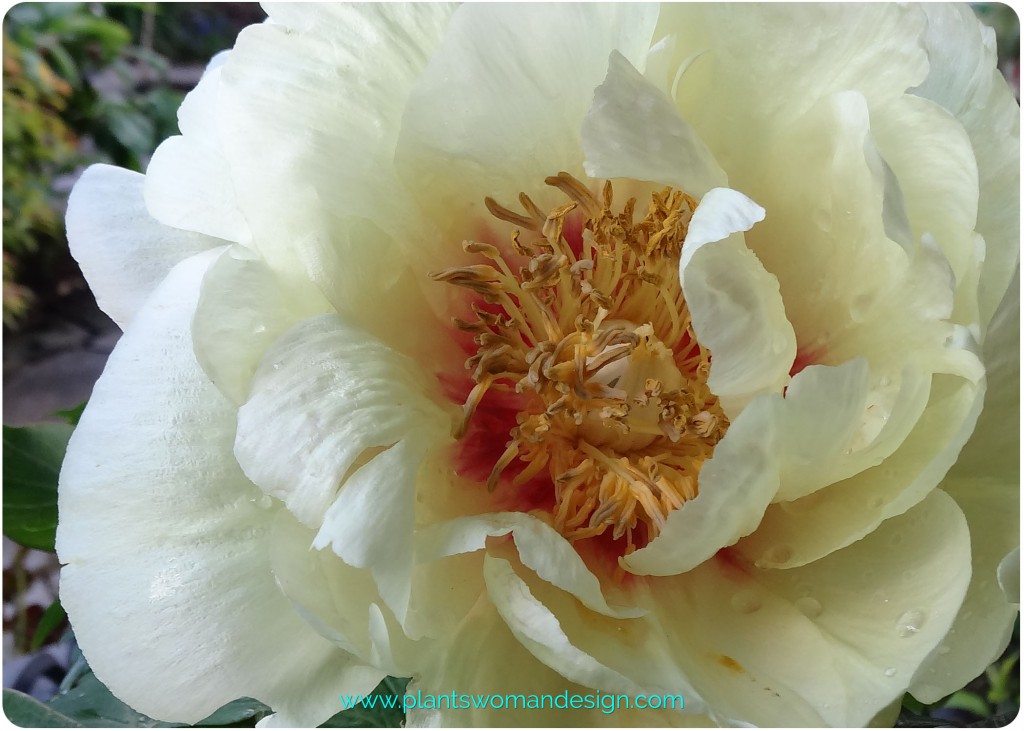
This peony was rescued from a house that was being torn down. She needed a good home and I was happy to give her one. I usually get only 2-3 blooms on this tree and they are worth seeking out.

I have had this spider azalea (rhododendron ‘linearifolium’) for 10 years. It is one of the plants I take with me every time I move house. I think it will come with me again. Now it is happy with lily of the valley at its feet and Ranunculus aconitifolius ‘flore pleno’ in the background.
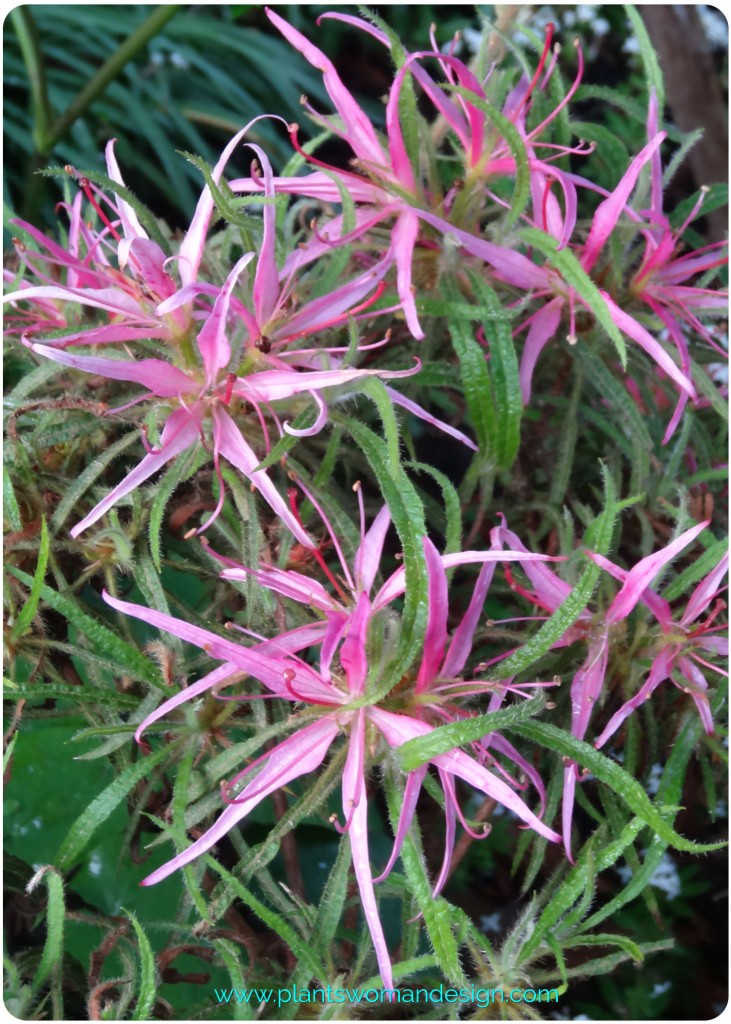
It is also rhododendron season here in the Pacific Northwest. They can look dull and uninteresting much of the year but right now they are the queens of the garden. Both of these large rhododendrons were from the previous owners. They are full and lush. I will share my secret for fabulous rhododendrons all year round in a future post.
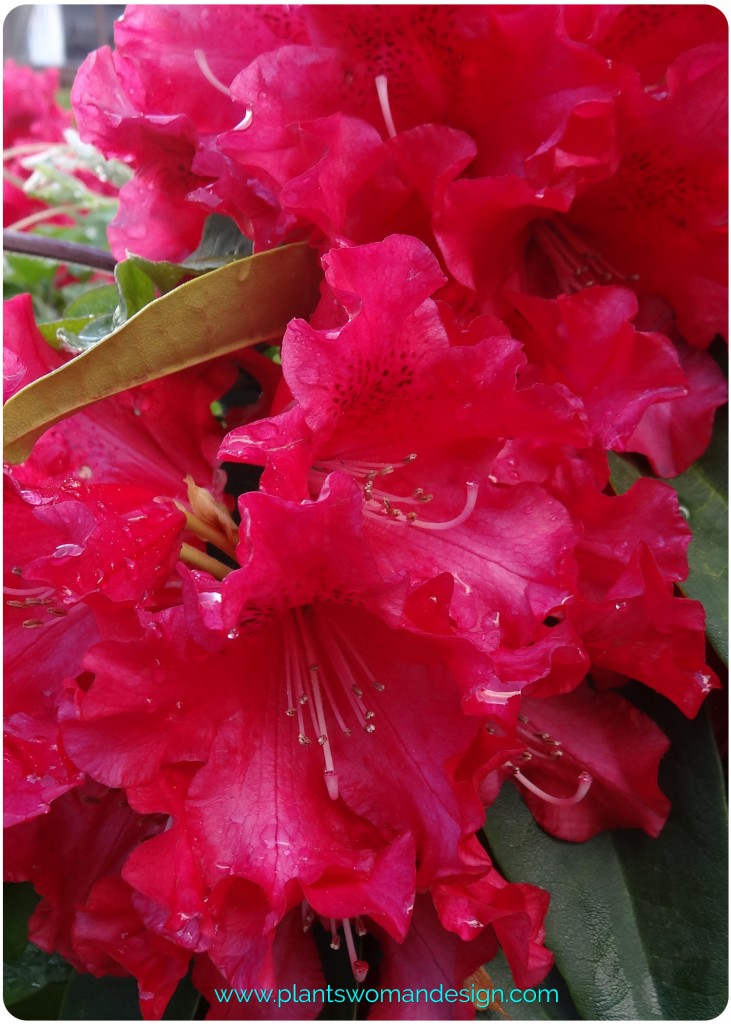
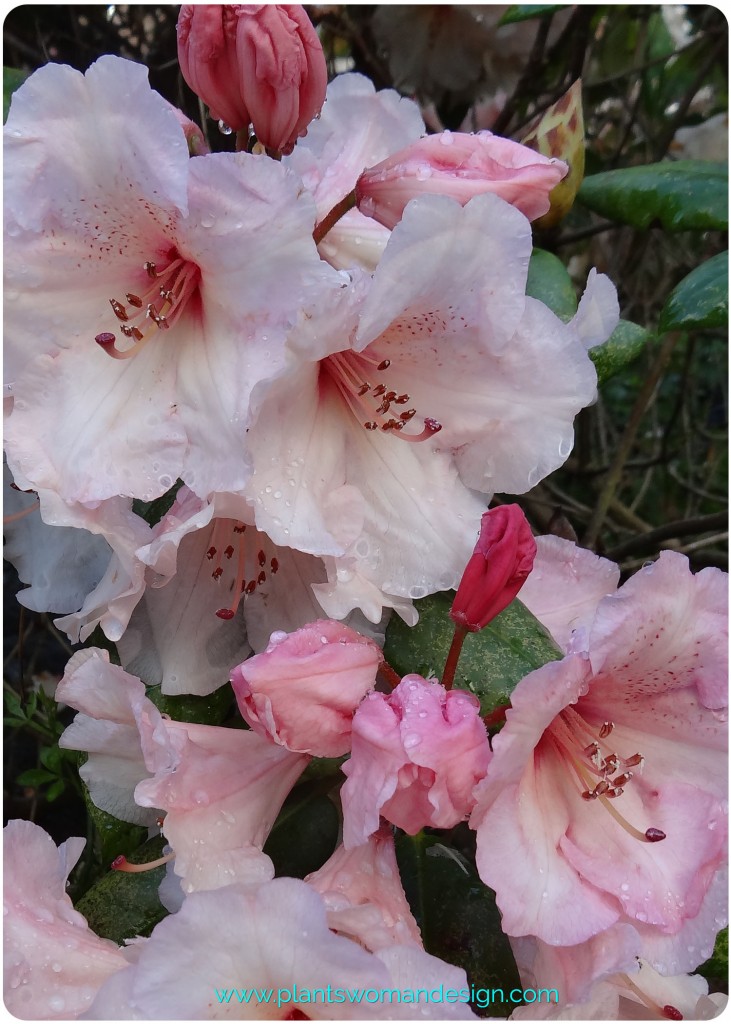
This sweet white rhododendron is rhododendron fragrantissima. Still in the pot it gets a special place by the door.
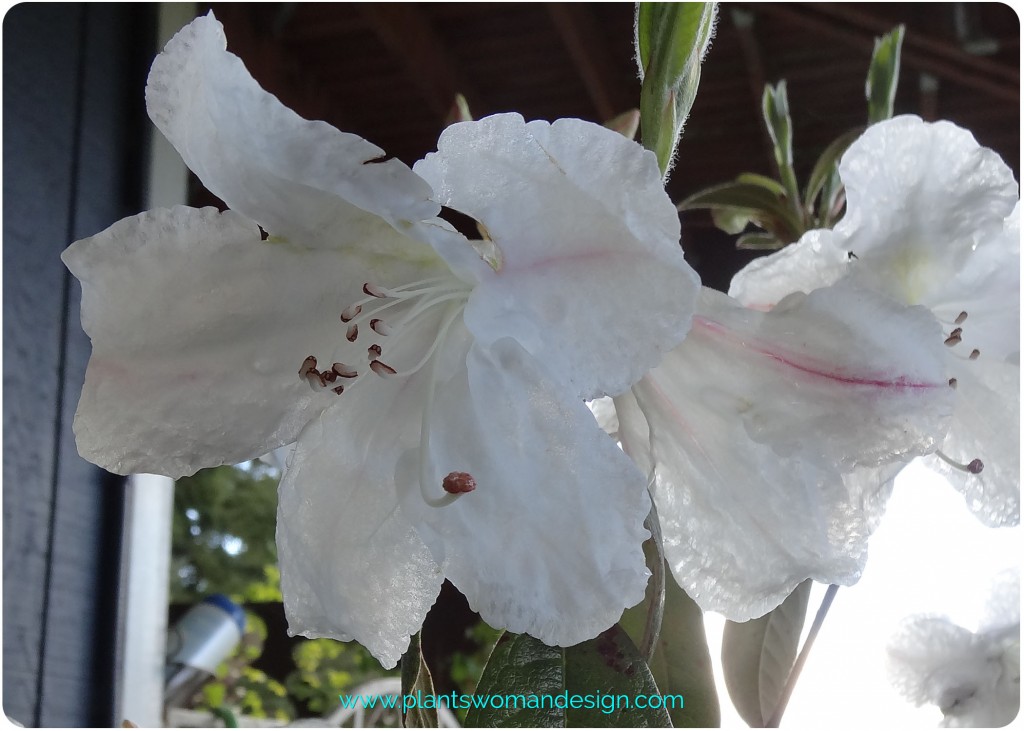
The excess moisture is what primroses thrive on. This candelabra primrose is happy in the mud and falling rain.
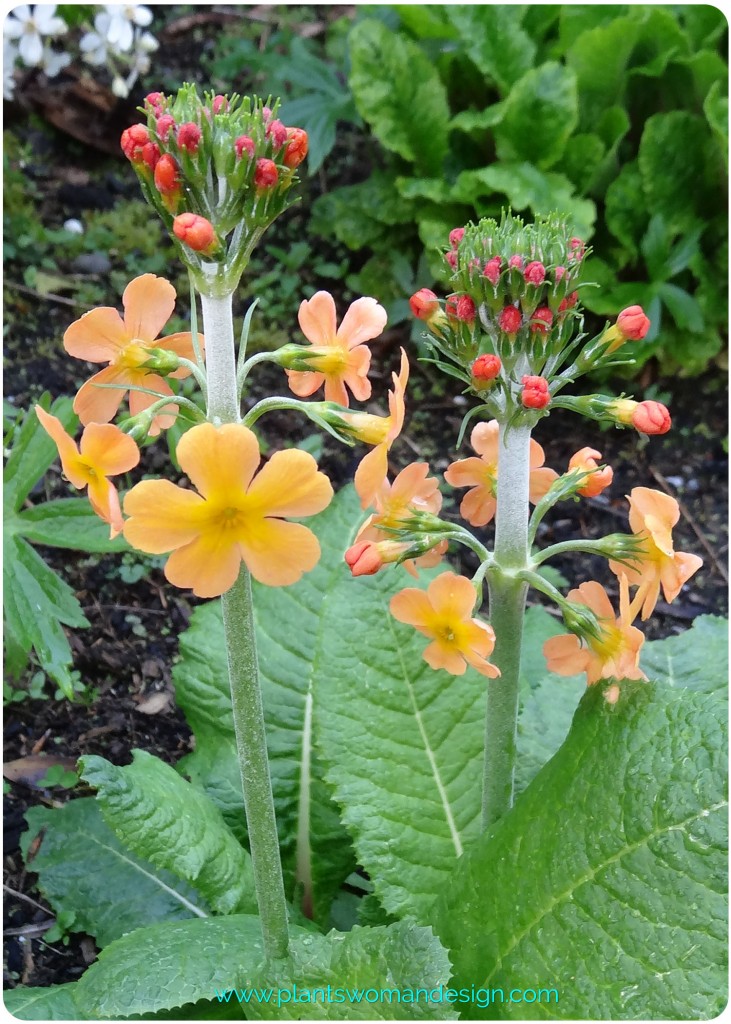
This blue aquilegia has just a touch of red in the bottom of the petals exactly the color of the barberry behind it. (It is actually Barberry ‘orange rocket’ but when the leaves are just coming out in the early spring they are very red).
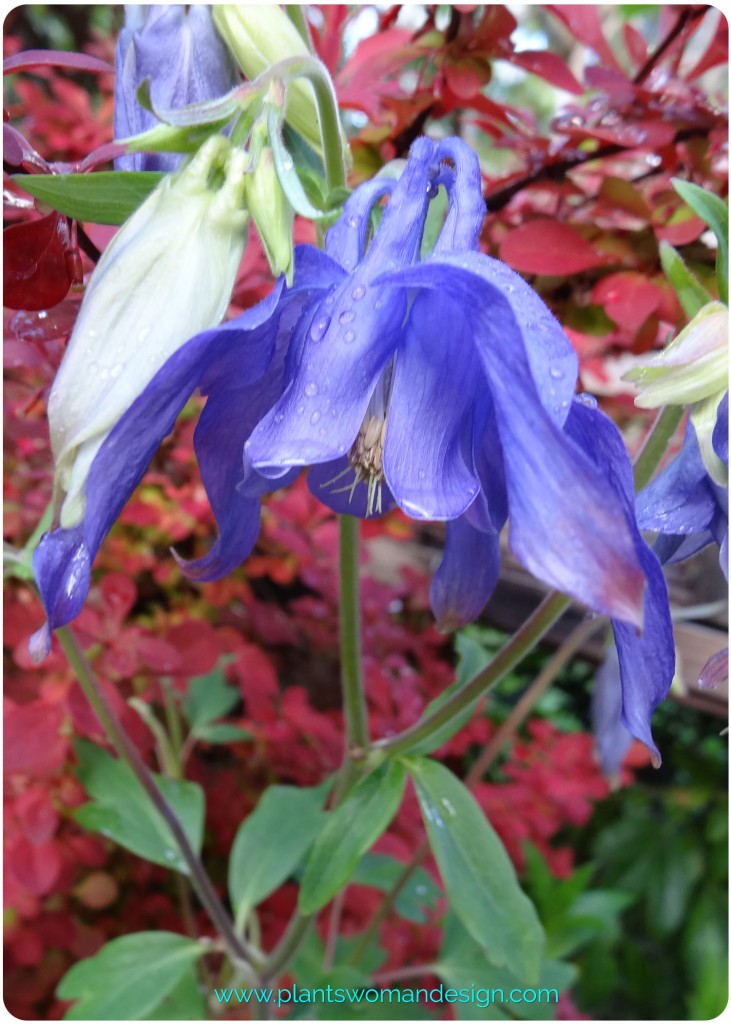
So, that’s what is happening in my garden right now. How are you faring with the rain and yuck? What are you seeing in your garden?
Send us a photo! You can email a photo and description to info{at}plantswomandesign{dot}com or upload it to our Face Book or Twitter pages. We’d love to see what’s going on in your yard and may have a little happy to send your way.
by Kristen | Jan 27, 2014 | gardening, Plantswoman Design
What, you may ask, does HHT stand for? Well, Horticultural Hot Topics of course!
As I head into the new year I often review the past year and think about goals for the coming year. What have I accomplished, what do I need to do, what do I want to do and what do I want to learn more about? This year is going to be great! I’m excited about new gardens to create including a cloister garden, a beach side sunken hot tub, and modern garden with a Petanque. Lots of times this involves research, learning new styles of gardens, and new ways to look at things. That really keeps me interested in the overall concept of gardening within different types of spaces and in new ways. Along these lines there are always some topics to think about. I love to hear what other people say about gardening and how that all effects where horticulture goes today and tomorrow. It gives time to think and reflect about where gardening has come from and where it is going.

The term ‘garden room’ has been around several years now. As gardeners, we were excited to think of a way to bring non-gardeners into the garden to help them start gardening. Right now there is a little bit of back lash against the ‘room’ concept in horticultural circles. More of what we are seeing is hard-scape and consumer related stuff. You can fill a garden room with all kinds of brick-a-brac (my mothers word for junk). Special ‘outdoor’ seating, lamps, cushions, rugs, lighting, containers, table top water fountains and…… so on. I think (and many of my contemporaries too) that the garden room should contain more PLANTS. After all, the connection with nature that we seek to promote probably should actually have something growing in it. My dirty fingers and muddy knees would have no place in many of the garden rooms I’ve been seeing. Gardening for the pleasure of gardening is being lost. To put a seed in the ground and see it turn into a tree is an AMAZING thing. It is not instant but it is amazing. Teaching a child to plant a sunflower and have it grow taller than the house is fairly easy and could possibly create a gardener for life. Whether you’ve got new plants, old plants, grafted plants or cuttings the garden should be about growing something. Caring for a plant, figuring out what is wrong with it , how to cultivate it and how to harvest it is the gardening experience. Years ago a cutting of a rose was taken from home and given to the newlyweds to take to their new house. The neighbor down the street shared her irises with anyone who would take them. Seeds were saved from vegetables to use the next year. Seeds were sometimes stolen in secret from botanical gardens so the gardener could have some of the same in their own gardens. Admittedly, I have a habit of gathering seeds from roadsides and pathways when I travel (I declare them at the border and check to see if they are on an invasive plant species list, and, even then, only grow them inside my greenhouse). And, even though I may be unsuccessful at times, I have had more fun trying to grow these reminders of fun places and times. So, I challenge you to grow something in your garden room, don’t just buy something for it, unless, of course, it’s a plant.

Invasive plants are still a hot topic within the horticultural main stream. They get lots of press about controlling them and eradicating them from your garden, the hedgerows, highways, and byways. I ran across a couple of chef’s in Texas that are ‘Eating the Invaders’. How cool is that? They plan a whole menu from invasive Himalayan blackberry cobbler (yes even in Texas the blackberry has spread) to wild boar. Wouldn’t it be so fun to plan a menu with blackberries, dandelions, lambs quarters, wakame, bullfrog legs, mussels, and other invasive species? Have a party to spread the word in a culinary way about the dangers to our coastlines and gardens. Interested? I’ve included a couple of links to get you started on “Eradication by Mastication.”
How about eating a Cricket Protein bar on your way to work? Read about that here.
Wondering about invasive species in the Northwest? Take a look here.
And check out what’s happening in Oregon here (I’m a little worried about eating sparrows)… Bon appetit!

While on vacation this holiday season I had the privilege of watching several shows about princesses, kingdoms, princes, and fairy land with my youngest grand daughter. (Yes she is 5) And while I’ve been graduated from “fairy land” for the last few years I did get to watch one really cool movie called the ‘Snow Queen’. The best thing about it is one of the villains was a gardener. Seriously! How many times to gardeners get to be a “bad guy”? Usually we are cast as wonderful nurturing beings. Loving the earth, helping to create a lovely place to live, growing food to give to family and friends, giving away flowers to the church, and visiting the poor with our over abundance of squash. This gardener was not! She grew and nurtured an ivy plant that would creep out of the garden and capture those who passed by her garden. Ultimately she was killed by her own creation and everybody (except the gardener) lived happily ever after. Of course I thought “how could that relate to me”? I’m loving,(except to pink flowers) gentle (except to weeds), kind (except to slugs), and love to share squash with anyone. Wait a minute maybe I’m the bad one. I will try this year to be a better gardener. I will accept and embrace the existence of flowers in any color, pull weeds and continue to feed them to the chickens instead of using a chemical that harms the soil, I will give my excess squash to my chickens and the goats next door instead of forcing it on my over “squashed” neighbors. Still hard to imagine becoming a fan of slugs but I do promise to continue using Eco-friendly slug bait that doesn’t harm the birds and pets in my garden.
What things are on your HHT this year? What things are happening in your neighborhood that make you want to stand up and speak out?
by Susan | Jan 18, 2014 | gardening, plants, Plantswoman Design
Before the holiday hit I left you with a few things to do to put your garden to bed (click here to read part 1). Today I want to talk about putting your bulbs away for the season. I was waiting for some cold weather to hit so I could pull up the begonias, allium and dahlias to show how to put them away until next year. We finally got a very good hard freeze that lasted for almost 2 weeks. I pulled all the bulbs the first day of the freeze and set them in the greenhouse to dry (it is important to dry them out). Though they don’t look like much, the big clumps of soil and dried leaves indicate there are tuber and bulbs in there.

 When the soil you pulled up with your tubers and bulbs is dry and eagerly falls off it’s time to get back to them to prep them for storage. Break away the extra soil and brush them clean with a big, soft brush. They need to be as dirt free as possible and dry.
When the soil you pulled up with your tubers and bulbs is dry and eagerly falls off it’s time to get back to them to prep them for storage. Break away the extra soil and brush them clean with a big, soft brush. They need to be as dirt free as possible and dry.
These are cleaned up and ready to store.


I use white wood chips for storing. Since I use them for the hen house I have them already, shredded newspaper also works. The boxes are saved from tulip bulbs delivered from on line purchases. Pack them loosely and don’t crowd them. My boxes end up on the floor of the garage (cool dark place, no moisture). You could also store them in a dry, cool basement or refrigerator.
 Here is one begonia still in the pot living happily in soil and the lights of the green house. It has a great dark ruffled leaf.
Here is one begonia still in the pot living happily in soil and the lights of the green house. It has a great dark ruffled leaf.

Spring is coming slowly but surely, it won’t be long until it is time to put your bulbs all back in the ground again. You can put bulbs like hardy allium and left over Tulips or Daffodils into the ground again right now. There is still enough time to get a chill factor for the spring bulbs although they may come up a little later. Did you purchase spring spring flowering bulbs at sales (I do sometimes and then forget to put them in the ground). I usually try and make sure to have them stored in a cool place to this point. I have a refrigerator in my garage that has mostly drinks, for my crew, and plant material in it. Consider yourself warned, if you go looking for a soft drink or beer you might have to fight through bulbs or chilling seedlings.
During the holiday’s I like to force paperwhites. Once they are done blooming inside I move them, intact, to the greenhouse. When I put my tender tubers and bulbs in the ground I also pop my paperwhites in as well. They will “reset” themselves and bloom next spring. Most information you read about forcing bulbs says to discard after they are finished blooming. I have successfully replanted them in this fashion and had a 50% success rate with re-blooming the next year. Make sure not to cut back the foliage but plant out with foliage intact they need the green leaves to re-energize the bulb for reblooming.

My garden is now put to bed. I use these winter months to start thinking and planning for the coming year. When it is time to put the tuberous begonias, non-hardy allium, and dahlias back out I’ll give you a little tutorial on how to prep them for planting.
Until then happy planting!
by Susan | Jan 13, 2014 | gardening, plants, Plantswoman Design
It’s exciting to start a new year and 2014 already looks to be a busy and fun year. Gardeners in our area look forward to the winter solstice with more expectation than Christmas. As the shortest day of the year, seeing the sun set at 4:24 is downright depressing but there is a silver lining. Every day after the solstice brings a few minutes of daylight back to us and leads us into the hopeful season of spring.
This year has been a dry year with lots of sun so I should really not complain. Even today the sun was amazing, high about 40 with a ring of beautiful snowy mountains around the horizon. I put the Christmas decorations away and started raiding the greenhouse. My little greenhouse is tucked under a deck. It has sun on one side for about 7 hours a day, no direct overhead sun. Because of this, I have several bands of florescent lights to provide the needed additional light. I am able to over winter bananas, echevarias, tropical lilys, water plants, and other tropical treasures. I also keep good collection of orchids which I rotate into the house through out their blooming seasons. Although orchids would like to have warm days and cool nights they also do fairly well with consistent temps. I keep their water in a separate container at greenhouse temp so they don’t get cold water. Fertilizing with orchid fertilizer also helps to get some good blooms.

One orchid that was wonderful throughout the entire holiday season was this little gem, Zygopetalum, fragrant orchid. It sent up a spike in October and I moved it into the house in November. I kept smelling this wonderful fragrance and couldn’t figure out where it was coming from. Finally it occurred to me to smell the orchid. Orchids usually have no strong scent, however, this one is one of the most fragrant of all . The spike held 10 flowers and the scent filled the room. I moved it into my bedroom for the rest of the season.

This plant, bilbergia nutans Queens tears, I picked up at the Northwest Flower and Garden Show about 3 years ago. It loves being outside in the summer and takes almost no water. This year I divided it into about 20 babies and put the old one back in the pot. They like to be pot bound to bloom but this was beyond pot bound. Some of the babies were blooming and were given away to new homes. They don’t really take too much effort just don’t water and don’t let freeze.

This is a portion of my orchid bench in my green house. I have two vanilla orchids – vanilla planifolia. If you want to read something funny google “how to grow your own vanilla”. When I got to the “every day for six weeks, wrap the pods in a wet blanket to sweat and at night unwrap” part ,(after waiting 9-12 months for the bean to mature, pollinating flowers in the morning with a chopstick, after waiting 3-5 years for plant to mature) I vowed I would never attempt to grow my own vanilla even though (technically) I could. That gardener’s idea of easy is very different than mine.

Another orchid out of my greenhouse is Purple and brown and smell’s like pepper.

Veltheimia bracteata (Forest Lily) – I got this bulb for last years garden show. I just wanted it for my own greenhouse but don’t order that often from San Marcos in California. A client said he cares for one in the window of his house. These are just coming into spike and bloom .
What things do you, my gardening friends, do to bring the out doors in? What are you over wintering in your green house? Don’t have a green house? That’s okay, if you did have a green house what would be in it?
by Susan | Jan 4, 2014 | gardening, Plantswoman Design

The Northwest Flower and Garden Show is fast approaching. The theme this year is “Art in Bloom” and let me tell you it’s been a fun theme to work with. Our focus is on the rhythm of the earth and how you can use garden space to help unwind and re-connect with nature. Now that the holiday season is over preparations are in full swing. We are working with Michelle Burgess from Michelle Burgess Designs and Ryan Blythe from Rainier Glass Studio (are you getting curious?). We’ve been checking up with our growers to see what plants will be ready and which ones won’t be. Plan “b” is ready just in case.
 Every year we need volunteers to help us around the show garden. Each volunteer has a 4 hour shift and the rest of the day to enjoy the show. You’ll spend your shift handing out brochures and answering general questions about the garden and Plantswoman Design. Would you like to join us? Leave a comment below or email us at susan[at]plantswomandesign[dot]com and we will get you set up.
Every year we need volunteers to help us around the show garden. Each volunteer has a 4 hour shift and the rest of the day to enjoy the show. You’ll spend your shift handing out brochures and answering general questions about the garden and Plantswoman Design. Would you like to join us? Leave a comment below or email us at susan[at]plantswomandesign[dot]com and we will get you set up.
 Over the next month we will have a lot to share with you. From info about the show to pre-show prep days right on through to the show itself. We will be posting regularly on our blog and our Face Book page. We may even have a few things to give away!!! Thinking about your garden already this year? Maybe it needs a little help? Stay tuned on how you can win a personal consultation with Susan and an personalized online idea book to help get your garden in shape this year.
Over the next month we will have a lot to share with you. From info about the show to pre-show prep days right on through to the show itself. We will be posting regularly on our blog and our Face Book page. We may even have a few things to give away!!! Thinking about your garden already this year? Maybe it needs a little help? Stay tuned on how you can win a personal consultation with Susan and an personalized online idea book to help get your garden in shape this year.
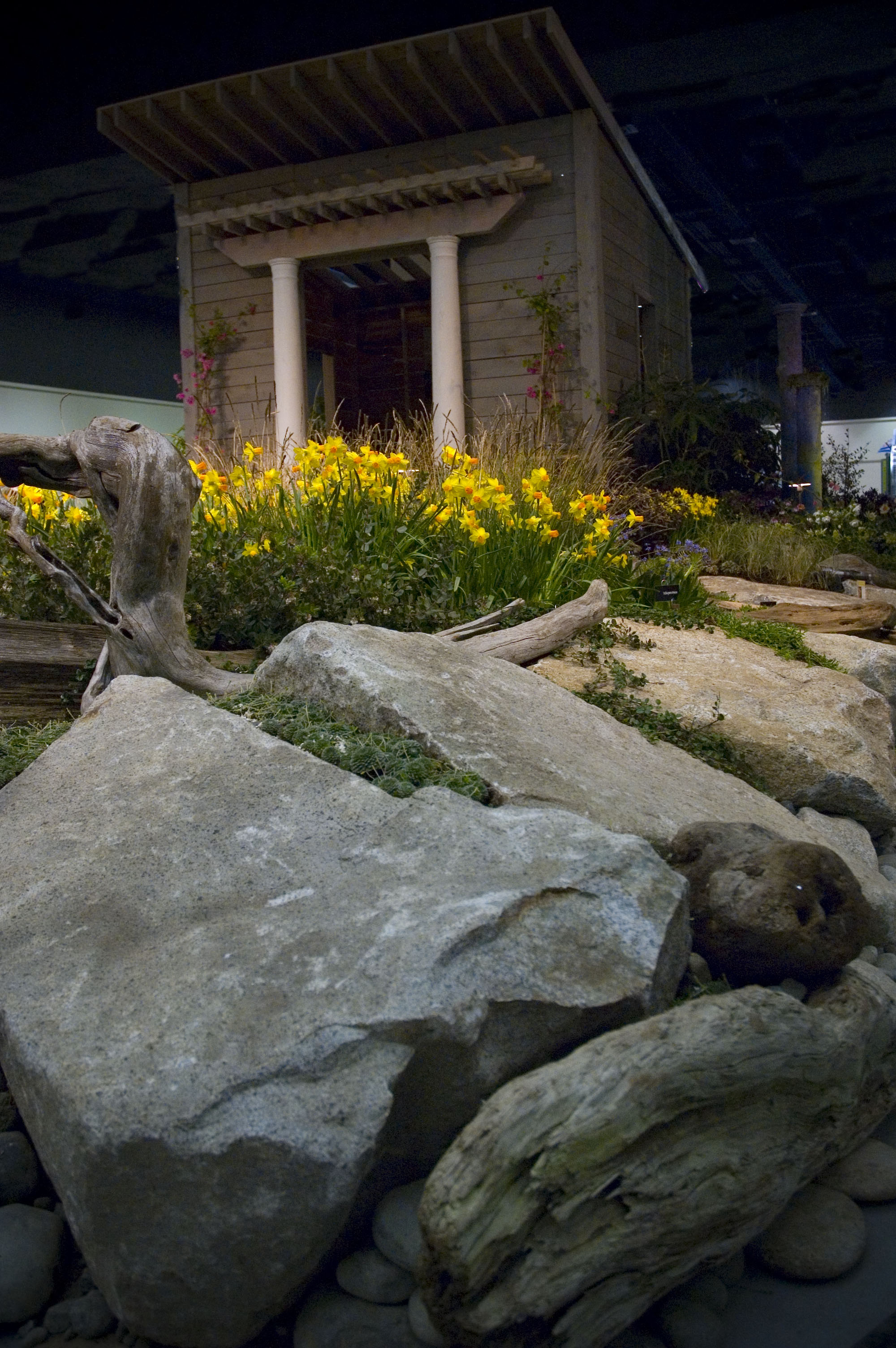
by plantswomandesign | Nov 23, 2013 | gardening, plants, Plantswoman Design
Smoke is rising from the chimneys, fog rolls down the bay, frost falls softly, quietly like snow on bare branches and dying leaves. Fall’s relentless march is fast fading into the dark misty morning and winter is close on it’s heels pushing its way in. The fabric of the garden changes dramatically overnight. Brilliance replaced by soft muted wheat colors, dusty purple, faded reds and oranges. Bare branches and stark silhouettes edge the once lush pathway. The time has come to tuck those tempermental, (temperiennials) into the garden for the winter.
As many of you know I love the huge foliage and exuberance of tropicalissimo. Every year I anticipate the window of time when I need to get them ready for the winter. Many of them can take the cold but can’t take the wet, many need mulch mounded around the base of their crowns to make it through a cold snap. There are many methods for doing this and I will share what I know and what has been successful in my garden.
I usually wait for the first quick frost to set the dormancy in motion. Sometimes we have great growing weather even in October and this year November. I have several plants that have already come into the greenhouse for overwintering that can take no frost. These have been in the greenhouse about 3 weeks now. A quick frost would kill the burgmansias, bouginvillas, and red bananas. The other things in my garden that are zone 8 can be successfully wintered over with help.
I have grown agaves in my garden for several years with only one making it through the winter. That winter I had a shrub growing nearby over hanging the plants. I had forgotten to cut it back during the summer and it was too late to do it by the time I noticed it. That next spring I found that where the shrub’s branches had covered the agaves they were alive and came through the winter fine. In the same bed where the branches didn’t reach the agaves they were dead. Ah Ha lesson learned. Now I use cut back pieces of my tall gingers to lay over the agaves. Their large leaves create air space and by waiting until they are nipped by frost they are not too heavy and full of moisture that they turn to mush on the ground.
 The Gunnera in the lower garden gets the same treatment. I use the leaves of the plant itself to give it protection. I cut them off and turn them upside down. The Gunnera signaled it’s dormancy early with curled dead edges on the leaves. This Gunnera is hardy here but by protecting the crown of the plant it takes less time to come back from dormancy and puts on fantastic growth each year.
The Gunnera in the lower garden gets the same treatment. I use the leaves of the plant itself to give it protection. I cut them off and turn them upside down. The Gunnera signaled it’s dormancy early with curled dead edges on the leaves. This Gunnera is hardy here but by protecting the crown of the plant it takes less time to come back from dormancy and puts on fantastic growth each year.
 Sometimes you can protect plants that are new to your garden for the first year in the same way. I put a Fremontodendron californicum (wooly flannel bush) in this year. I protected it with cut bamboo over the branches and crown. Because it has a branching structure already and is not completely herbaceous I didn’t want to lay anything too heavy to weigh down the branches. It hates water and is planted in gravel here. I’ll let you know if it survives. (If you want to read something interesting look up this plant on the internet. It has so much conflicting information published about it! One site says frost tender zone 8 and another say hardy to negative 20)
Sometimes you can protect plants that are new to your garden for the first year in the same way. I put a Fremontodendron californicum (wooly flannel bush) in this year. I protected it with cut bamboo over the branches and crown. Because it has a branching structure already and is not completely herbaceous I didn’t want to lay anything too heavy to weigh down the branches. It hates water and is planted in gravel here. I’ll let you know if it survives. (If you want to read something interesting look up this plant on the internet. It has so much conflicting information published about it! One site says frost tender zone 8 and another say hardy to negative 20)
 After the first frost I do cut down the gingers, cannas, and dahlias. I spread a thin layer of dry mulch over the top and also add fallen leaves over that. I use washed cow manure because it has nutrients to add to the soil as it decomposes. I leave these bulbs and temperiennals in the ground. They multiply and come back each year. My soil has lots of organic material in it and drains freely.
After the first frost I do cut down the gingers, cannas, and dahlias. I spread a thin layer of dry mulch over the top and also add fallen leaves over that. I use washed cow manure because it has nutrients to add to the soil as it decomposes. I leave these bulbs and temperiennals in the ground. They multiply and come back each year. My soil has lots of organic material in it and drains freely.
 Tuberose begonias get to come inside after the frost as well. They have been still growing and filling the spaces with fabulous oranges and reds until this frost. Prolonged freezing of these bulbs will result in death so don’t leave them outside. Again the frost helps the bulb know dormancy so the bulbs can be stored for winter.
Tuberose begonias get to come inside after the frost as well. They have been still growing and filling the spaces with fabulous oranges and reds until this frost. Prolonged freezing of these bulbs will result in death so don’t leave them outside. Again the frost helps the bulb know dormancy so the bulbs can be stored for winter.
It’s time to put the garden to bed. Stay tuned for our next post with more helpful information.
by plantswomandesign | Nov 14, 2013 | gardening, plants
Autumn is a time when everything starts to die back. The fun fluffy perennials, crazy growing annuals and lush trees change and start to go dormant. One of the best things about grasses is they begin to really put on a show. As they enter fall they look the best of their entire season of interest. The wonderful greens and infloresenses blend into a mixed bed but when the cool weather hits the other plants bow out and the grasses take center stage.
 Many people have a love/hate relationship with grasses. Some designers think they should only be used in full sweeps relegated to grass gardens and not integrated into garden beds. Others think they can be used in any situation and can translate into any style. I do like to use grasses in many situations but not in every situation. Most grasses are happy in full sun and bright areas with long vistas to view them at a distance. There are also lovely shade grasses available, usually showing up as bright spots in a dark area.
Many people have a love/hate relationship with grasses. Some designers think they should only be used in full sweeps relegated to grass gardens and not integrated into garden beds. Others think they can be used in any situation and can translate into any style. I do like to use grasses in many situations but not in every situation. Most grasses are happy in full sun and bright areas with long vistas to view them at a distance. There are also lovely shade grasses available, usually showing up as bright spots in a dark area.

hakonechloa macra aureola in a shady bed
The scale of a grass can sometimes overwhelm their surroundings become the dominate feature. Using them where they are happy and can maintain their upright sunniness will reward the gardener. Note how the Hakonechloa is balanced with shrubs that can maintain their own space in the garden with this, sometimes aggressive, grass nearby.
I love working with texture in the garden. Leaf color and shapes add so much more interest than just flowers. One area I really like to use grasses is in a beach garden. The color of the light near the water and scope of vision is fun to play with. I also like to play the soft light grasses against hardscape. The summer brings contrast between sun warmed rock surface and cool lush grasses while the same area becomes contrasted between the now cool gray surface and warm autumn tinted grasses in the fall.

pennisetum ‘red head’
 Some of my favorite grasses are:
Some of my favorite grasses are:
Panicum virginitum ‘Shenandoah’ Sheanandoah switch grass – Grows to 3-4 feet hardy from zone 5 – 9, Interest from July to February. lovely green soft colors and brilliant red tips and yellow in the fall. Panicles are red tangling with orange bits held above foliage. Winter color is wheat color with seed heads persisting through the season. Good in any soil, loves good strong light.

Panicum virginitum ‘Shenandoah’ Sheanandoah switch grass

leaf color on Panicum ‘Shenandoah’
Chionochloa Rubra – Red Tussock Grass – A drought tolerant evergreen grass with interest all year long. grows about 3 fee tall in my garden by about 4 feet spread. soft green in summer with color change to coppery wheat color in winter and back to green again. zone 7 – 9 grown in full sun with little water is when it looks the best!. Thin leaves and panicles dance in the slightest breeze.

Chionochloa Rubra – Red Tussock Grass
A dwarf miscanthus called ‘Little Kitten’ is also a favorite. I love Miscanthus but it is often too big for a normal garden bed and they don’t typically mix well with other plants when they are 6- 8 ft tall and very dominate. This gem is 3-4 feet in height. Has the typical miscanthus inflorescence on top. They stay upright and turn a fabulous fall color with all the colors of fall on the same plant Full sun, any soil, good drainage and not too wet are its best conditions. Zone 5-9.

‘Little Kitten’
I usually leave the grasses up until the late winter or even spring. If we have a snow I will cut them back after they are laying over. Birds use the seeds and small animals will overwinter in the dry area beneath the leaves. I will leave you with a border from one of my beach gardens. This has a lovely mixture of perennials, sedums, grasses, and small shrubs for a border that looks great all year long.

by plantswomandesign | Nov 6, 2013 | gardening, plants, Plantswoman Design
It is a beautiful day here on the west coast. It has been spectacular weather for fall color and feeling. Nippy in the morning with a tinge of wood smoke and fallen leaves in the air. Afternoons are sunny and you can see the sun on the horizon moving away to the south of the garden. Sunrises are coming up later and later with more awesome colors than I can describe.
These days I spend about 1 day a week prepping for the Northwest Flower and Garden show. I’m ordering plant material, picking it up and nestling it into the greenhouses that will hold our plant material until February. I have already ordered many flats of bulbs for the show that will be forced at their location and brought to the show blooming (hopefully). It is not an exact science so we do our best and have a plan B.
I always like to feature different types of plants in my show gardens. That is one of the reasons I first started coming to the flower and garden show all those years ago. I wanted to see something new and learn about what others were growing. Many times I saw something I had never seen before and I learned about it at the show. Now I guess I am a little jaded since entering the horticultural world. As a designer I get to see a lot of new plants and now say ‘I have one of those’ instead of ‘I want one of those’ and sometimes I have to say “Yep, I’ve killed one of those’.

- White Bouquet, Candy Club
iris reticulata natascha, fritillaria meleagris alba
As I prepare for the show I know I want some different types of bulbs. So on to the Van Engelen site I go and order some bulbs. I found these great (I hope) things called bunching tulips. They have multiple stems coming from the bulb with multiple flowers on them. I had never seen them before so I called my grower and asked about them. He said they had been around for several years and didn’t really sell well so they stopped growing them. Hmmm… Of course that means I have to try them. I ordered candy club and white bouquet.
Last year I forced Allium shubertii. It was difficult because they are a summer blooming bulb but I had about a 50% success rate. If the bulb blooms early in the year it is easier to force. If you plan on forcing bulbs you can count on at least a 12-14 week chill factor. That means you would place the bulbs into a dark 40-45 degree place in moist soil. Then add the actual blooming time and you will have a fairly good idea when to expect them. The folks at Van Engelen can help you with guesstimating if you are unsure. I received the order and put them into the shop refrigerator that has drinks and snacks for the crew. They had to put up with the boxes of bulbs for a couple of weeks… small price to pay, right?

Today I mixed up a fast draining soil mixture and added some bulb food. I placed the several bulbs in containers with the soil. I pack them together because I want the pot to be full and bursting with color. I don’t usually do that in the ground especially if they are naturalizing bulbs.
I also potted up some iris reticulata natascha, and some white blooming fritillaria meleagris alba.
I think maybe you can guess what color scheme I’m going for the show. I’m excited to do a more formal limited color palette this year.

I also could not resist adding some Christmas color into the forcing planting. I potted up some Amaryllis ‘nymph’ and amaryllis ‘white nymph’ for the Christmas season. I soak the bulbs overnight if the roots are dried out at all. Then I put them into the same bulb mixture as the tulips with fast draining soil and bulb food. I like planting the amaryllis in a soil mixture instead of plain water because I think water can stagnate sometimes and the bulb will rot. These are in my greenhouse now and not chilled. They will stay here until they start to bud. If it is close to Christmas they will go into the house. If they start too early I will move them to a cool frost free place to save the blooms until closer to Christmas.
I’m excited to see how these work into the Christmas scheme. Let me know if you have tried forcing bulbs before and how they turned out.
www.plantswomandesign.com | copyright 2013
by plantswomandesign | Nov 6, 2013 | gardening, Plantswoman Design
It is a beautiful day here on the west coast. It has been spectacular weather for fall color and feeling. Nippy in the morning with a tinge of wood smoke and fallen leaves in the air. Afternoons are sunny and you can see the sun on the horizon moving away to the south of the garden. Sunrises are coming up later and later with more awesome colors than I can describe.
These days I spend about 1 day a week prepping for the Northwest Flower and Garden show. I’m ordering plant material, picking it up and nestling it into the greenhouses that will hold our plant material until February. I have already ordered many flats of bulbs for the show that will be forced at their location and brought to the show blooming (hopefully). It is not an exact science so we do our best and have a plan B.
I always like to feature different types of plants in my show gardens. That is one of the reasons I first started coming to the flower and garden show all those years ago. I wanted to see something new and learn about what others were growing. Many times I saw something I had never seen before and I learned about it at the show. Now I guess I am a little jaded since entering the horticultural world. As a designer I get to see a lot of new plants and now say ‘I have one of those’ instead of ‘I want one of those’ and sometimes I have to say “Yep, I’ve killed one of those’.

White Bouquet, Candy Club
iris reticulata natascha, fritillaria meleagris alba
As I prepare for the show I know I want some different types of bulbs. So on to the Van Engelen site I go and order some bulbs. I found these great (I hope) things called bunching tulips. They have multiple stems coming from the bulb with multiple flowers on them. I had never seen them before so I called my grower and asked about them. He said they had been around for several years and didn’t really sell well so they stopped growing them. Hmmm… Of course that means I have to try them. I ordered candy club and white bouquet.
Last year I forced Allium shubertii. It was difficult because they are a summer blooming bulb but I had about a 50% success rate. If the bulb blooms early in the year it is easier to force. If you plan on forcing bulbs you can count on at least a 12-14 week chill factor. That means you would place the bulbs into a dark 40-45 degree place in moist soil. Then add the actual blooming time and you will have a fairly good idea when to expect them. The folks at Van Engelen can help you with guesstimating if you are unsure. I received the order and put them into the shop refrigerator that has drinks and snacks for the crew. They had to put up with the boxes of bulbs for a couple of weeks… small price to pay, right?

Today I mixed up a fast draining soil mixture and added some bulb food. I placed the several bulbs in containers with the soil. I pack them together because I want the pot to be full and bursting with color. I don’t usually do that in the ground especially if they are naturalizing bulbs.
I also potted up some iris reticulata natascha, and some white blooming fritillaria meleagris alba.
I think maybe you can guess what color scheme I’m going for the show. I’m excited to do a more formal limited color palette this year.

I also could not resist adding some Christmas color into the forcing planting. I potted up some Amaryllis ‘nymph’ and amaryllis ‘white nymph’ for the Christmas season. I soak the bulbs overnight if the roots are dried out at all. Then I put them into the same bulb mixture as the tulips with fast draining soil and bulb food. I like planting the amaryllis in a soil mixture instead of plain water because I think water can stagnate sometimes and the bulb will rot. These are in my greenhouse now and not chilled. They will stay here until they start to bud. If it is close to Christmas they will go into the house. If they start too early I will move them to a cool frost free place to save the blooms until closer to Christmas.
I’m excited to see how these work into the Christmas scheme. Let me know if you have tried forcing bulbs before and how they turned out.
www.plantswomandesign.com | copyright 2013

















































